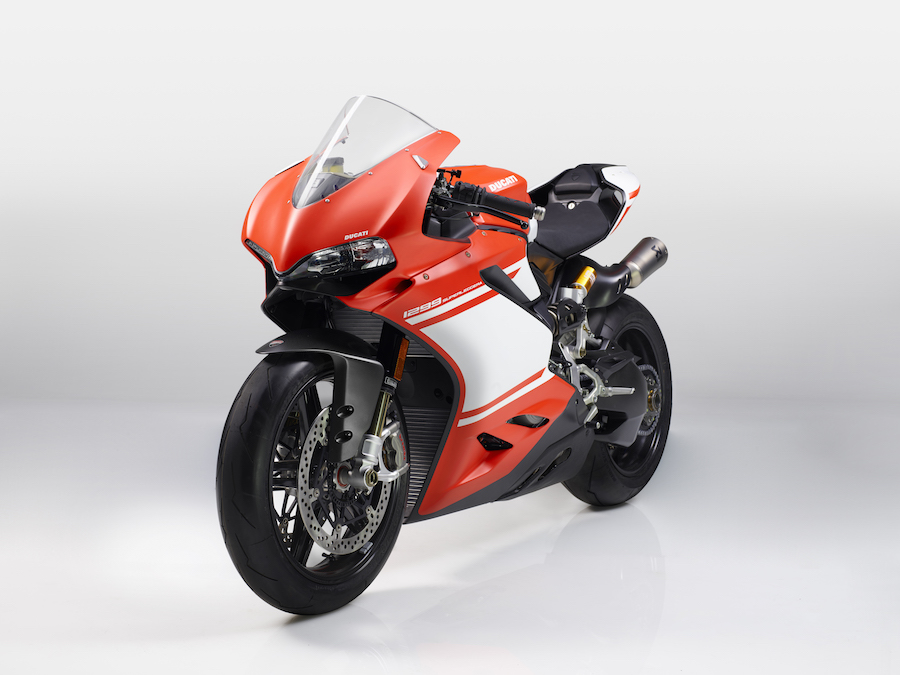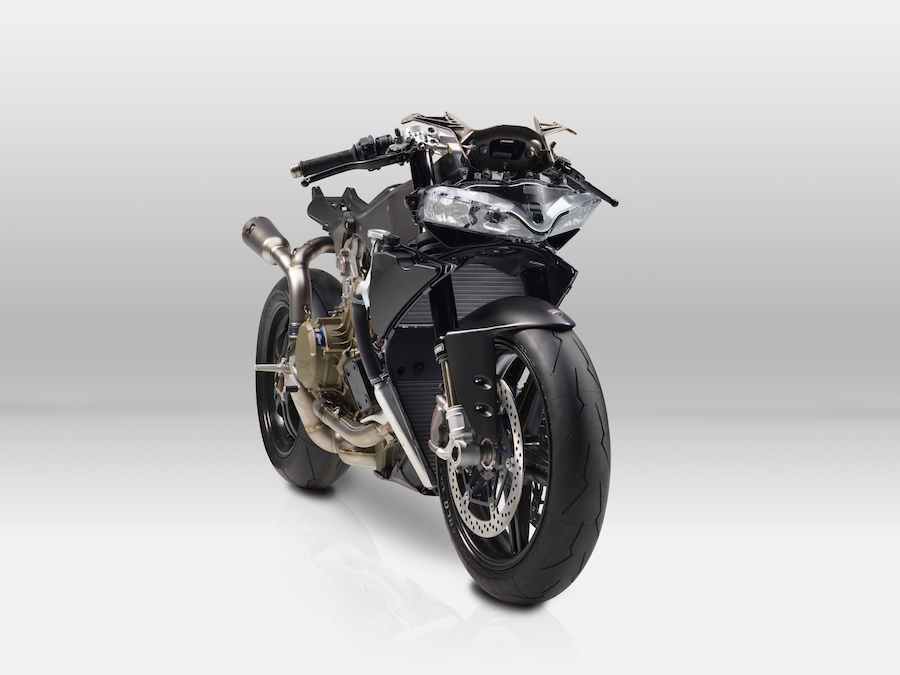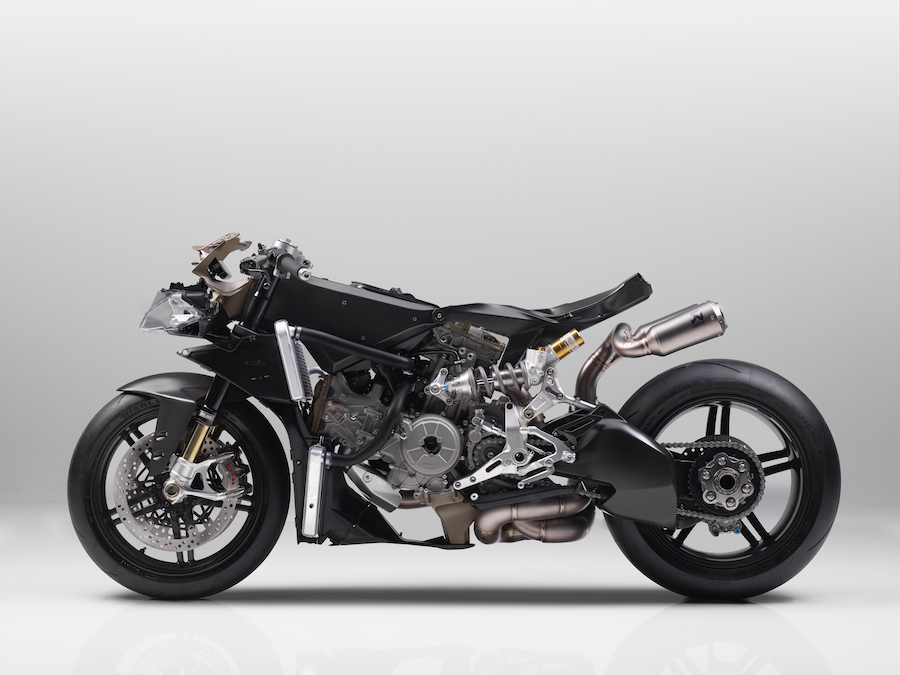What makes the 1299 Superleggera even more exclusive is the new electronics package which uses a 6-axis Inertial Measurement Unit (6D IMU) to manage the incomparable array of electronic controls. This system brings improvements to the Ducati Traction Control EVO (DTC EVO) presented on the 1299 Panigale S Anniversario thanks to the introduction of Ducati Slide Control (DSC), which ensures even higher out-of-the-corner performance.
The 1299 Superleggera is also the first ever Ducati Superbike to be equipped with Ducati Power Launch (DPL) and also features the Engine Brake Control (EBC) seen on previous versions. Keeping the explosive performance of the 1299 Superleggera under control is also a newly calibrated Bosch Cornering ABS system that ensures matchless braking in complete safety.
The 1299 Superleggera has the word ‘exclusive’ written all over it, even when it comes to the number being made: only 500 such bikes are to be built. Together with the motorcycle, purchasers get a track kit which includes a complete Akrapovič titanium racing exhaust, a racing screen, plate holder removal kit, kickstand removal kit, machined-from-solid mirror replacement plugs, front and rear paddock stands and a bike cover.

Ducati 1299 Superleggera – Features
- Carbon fibre monocoque frame
- Carbon fibre single-sided swingarm
- Carbon fibre wheels with aluminium hubs
- Carbon fibre rear subframe
- Aluminium tank
- Carbon fibre fairing
- Multi-adjustable Öhlins FL936 upside down 43 mm fork
- Multi-adjustable Öhlins TTX36 shock absorber with titanium spring
- Brembo MCS 19.21 radial front pump
- Brembo TT29OP1 brake pads with increased friction coefficient
- ID number on top yoke: 1/500
- Superquadro engine with 215 hp at 11,000 rpm and 14.9 kgm at 9,000 rpm
- 2-segment pistons with a diameter of 116 mm to boost the compression ratio and aluminium cylinder liners to reduce weight
- Lighter crankshaft with tungsten balancing pads
- Titanium con rods
- Sand-cast crankcase
- Increased-diameter titanium intake and exhaust valves
- Cylinder head with specially developed intake and exhaust ducts
- Camshafts with increased lift
- Complete all-titanium Akrapovič exhaust with high-mount dual silencer*
- 6D Inertial Measurement Unit (IMU) by Bosch
- Ducati Traction Control EVO (DTC EVO)
- Ducati Slide Control (DSC)
- Ducati Wheelie Control EVO (DWC EVO)
- Engine Brake Control (EBC)
- Bosch Cornering ABS
- Ducati Power Launch (DPL)
- Ducati Quick Shift (DQS) up/down
- Dedicated switchgear controls to adjust DTC, DSC, DWC and EBC during on-track use ad DPL activation
- Ducati Data Analyser + (DDA+)
- Lithium-ion battery
Ducati 1299 Superleggera Race Kit
- Complete titanium Akrapovič racing exhaust with high dual silencer
- Bike cover
- Front and rear paddock stand
- Plate holder removal kit
- Racing screen
- Kickstand removal kit
- Machined-from solid mirror replacement plugs
Superbike Suspension and brakes
The refined chassis set-up of the 1299 Superleggera is completed by Öhlins suspension and true Superbike-calibre Brembo brakes. The multi-adjustable 43 mm Öhlins FL936 upside-down fork on the 1299 Superleggera weighs 1.35 kg (3 lbs) less than the Öhlins fork on the Panigale R. At the rear, instead, the multi-adjustable Öhlins TTX36 shock absorber has a titanium spring that shaves off another 0.5 kg (1.1 lb) with respect to the steel unit fitted on the Panigale R.
A look at the braking system reveals two 330 mm Brembo discs up front, gripped by Brembo M50 monobloc calipers, with new TT29OP1 brake pads, controlled by a Brembo MCS 19.21 radial pump. At the back, instead, is a single 245 mm disc.
The most powerful Superquadro ever
A whopping 215 hp at 11,000 rpm and 14.9 kgm at 9,000 rpm. These are the incredible power and torque values delivered by the Superquadro twin cylinder engine that powers the 1299 Superleggera. To achieve such performance Ducati engineers have made profound changes to some of the main engine components, starting with the lightened crankshaft which has a larger crank pin and tungsten balancing pads.
The con-rods, in titanium, are new, as are the 116 mm diameter pistons – now with just two segments as on Superbike engines – with machined crowns that raise the compression ratio to 13:1.
Another important new development concerns the cylinder liners, in aluminium as opposed to steel as seen on the 1299 Panigale. With the addition of a lighter flywheel, the “engine core” (crankshaft, conrods, pistons, cylinder liner, flywheel) is about 2.4 kg (5.3 lbs) lighter than its counterpart assembly on the 1299 Panigale (-21.5%).
The cylinder heads have also been given an overhaul. The diameters of the valves, both in titanium, have been increased; they are now even wider than those used on Superbike competition bikes. The intake valves have a diameter of 48 mm as opposed to the 46.8 mm on the 1299 Panigale; the exhaust valves have a diameter of 39.5 mm (against 38.2 mm on the 1299 Panigale). Consequently, intake and exhaust ducts have also undergone development, improving fluid dynamics thanks also to new camshafts that offer both improved profiles and increased valve lift. This model has been the focus of intense performance and weight reduction research, and the cylinder heads are no exception: their weight has been cut by about 0.4 kg (0.9 lbs).
The 1299 Superleggera features a clutch with new slipper and self-servo system, giving heightened ‘feel’ and ride stability thanks also to the use of a new forged aluminium clutch basket.
Increased performance has, naturally, required the adoption of technical solutions to ensure reliability and compliance with noise emissions standards. Numerous parts of the twin-cylinder engine have been modified: for example, the crankcase is now sand-cast and the new timing system features a “silent” chain.
Overall, then, in terms of weight, the Superquadro, is 2.1 kg (4.6 lbs) lighter than the engine on the 1299 Panigale.
The intake system on the 1299 Superleggera has also been revised. It mounts a high-permeability, larger-surface P08 Sprint Filter of SBK derivation. The throttle body features new aerodynamic throttle openings with a profile designed to improve airflow while intake horn heights have been optimised for each cylinder head, unlike the 1299 Panigale which has horns of the same length.
Lastly, the 1299 Superleggera has a complete all-titanium Akrapovič exhaust with a high dual silencer, just like the one on the official Panigale that competes in the World Superbike championship.
The Superquadro that powers the 1299 Superleggera is not just the most powerful twin-cylinder road engine built by Ducati in its entire history: it’s also perfectly EURO 4 compliant and delivers 10 hp (+ 4.9%) and 0.2 kgm (+ 1.5%) more than the engine on the 1299 Panigale.
Moreover, the ultra-light lithium battery on the 1299 Superleggera saves 1.7 kg (3.7 lbs) compared to the unit on the 1299 Panigale.
For those aiming to use the bike only on the track, the 1299 Superleggera comes with a track kit that, as regards the engine, includes a complete Akrapovič titanium exhaust. This exhaust is 4kg lighter than its road counterpart and boosts power by 5 hp.

HyperFocal: 0
MotoGP electronics
The 1299 Superleggera is the first Bologna-built bike to be equipped with the new electronic package, which make full use of the 6-axis Inertial Measurement Unit (6D IMU). This electronic package includes DTC EVO, DSC, DWC and EVO and provides the rider with a bike control experience that comes extremely close to that of a MotoGP bike.
DTC EVO
The DTC EVO on the 1299 Superleggera derives from the system already presented on the 1299 Panigale S Anniversario and is based on an all-new algorithm that ensures faster, more precise intervention. The DTC EVO interfaces with the Bosch Inertial Measurement Unit (IMU), constantly measuring the motorcycle’s lean angle and using it to accurately calculate the degree of intervention needed to ensure suitable rear wheelspin (according to the DTC EVO level setting) and so provide better handling. Moreover, the DTC EVO also acts on the throttle body valves and controls spark and injection advance. In all situations in which fast intervention of the DTC EVO is not required, use of the throttle body valves ensures maintenance of optimal combustion parameters, ensuring more fluid engine response and intervention.
With simpler types of traction control, detection of rear wheelspin sees the system intervene to hold it in check. When optimal grip is re-established the system reduces intervention until spin reoccurs, and the cycle repeats. This produces a graph that shows intervention oscillating around a theoretical “ideal intervention line” that represents the traction limit. DTC EVO reduces the magnitude of those oscillations, making the system operate closer to the perfect intervention line. This is particularly advantageous in situations where grip changes, such as when the rear tyre becomes worn.
In addition to this enhanced intervention precision, when set to “1” or “2”, the DTC EVO adds a new function that lets the user ride the motorcycle at a level that would previously only have been possible for experts or pros. Now, when the bike is leaned over, the rider can use the throttle to request more wheelspin than that obtained with the normal intervention level, allowing the motorcycle to pivot around its front wheel and complete the cornering line. DTC EVO allows riders to do this while keeping safety parameters under control, effectively letting then ‘close’ the taken line with the rear wheel.
Ducati Slide Control (DSC)
The introduction of the 6D IMU has allowed Ducati Slide Control (DSC) – developed jointly with Ducati Corse – to be added to Ducati Traction Control EVO (DTC EVO). This new system provides the rider with further support by controlling the torque delivered by the engine as a function of the slide angle; its goal is to improve out-of-the-corner performance by preventing slide angles that might otherwise be difficult to handle. The DSC relies on the 6D IMU that provides the vehicle control unit with crucial information of motorcycle dynamics (such as lean angle, acceleration and much more). Thanks to this data – and depending on the user-selected level – the DSC extends the performance range of the bike for everyone, providing improved assistance under extreme riding conditions.
Like the DTC EVO, the DSC controls torque reduction by acting on the throttle body valves, decreasing spark advance and reducing injection. In every situation in which fast intervention of the DSC is not required, use of the throttle body valves ensures maintenance of optimal combustion parameters, ensuring more fluid engine response and intervention.
DSC has three different settings: switching from level 1 to level 3 results in easier control of slide angles that would otherwise be difficult to handle. DSC intervention levels can be changed by going to the menu, from where you can also set the DTC EVO and DWC EVO values. It’s also possible to set direct DSC control via the Up and Down keys on the left handlebar. The DSC setting is always shown on the display.
Ducati Wheelie Control EVO (DWC EVO)
The 1299 Superleggera also comes equipped with the latest version of Ducati Wheelie Control (DWC). This system – again with the EVO tag – has been overhauled in terms of both controller structure and algorithm, providing a closer link with the rider’s needs. This is an evolution of the system that equips the 1299 Anniversario.
Ducati Power Launch (DPL)
Another new feature on the 1299 Superleggera is Ducati Power Launch (DPL), the first time it has appeared on a Panigale. This 3-level system ensures lightning-fast starts, letting the rider focus on releasing the clutch. Once set, the rider simply engages first gear and opens the throttle. During the first stage of moving off, while the rider is modulating clutch release, the DPL stabilises the engine at optimal revs as a function of the selected level. In the second phase, when the clutch has been fully released, the DPL controls torque delivery to give acceleration that matches the chosen level. The DPL makes use of the DWC functions and always keeps DTC active to ensure complete safety at all times.
Automatic disengagement of the system occurs above the end-of-start speed, or once third gear is selected. To protect the clutch, a specially developed algorithm allows only a limited number of consecutive starts. The number of ‘launches left’ returns to its normal status once the user rides the bike normally.
The DPL has three different levels, set by simultaneously pressing the Up and Down keys on the left handlebar. Level 1 favours high-performance starts, level 3 is safer and more stable.
Bosch Cornering ABS
The 1299 Superleggera also features a revised Bosch Cornering ABS system. First of all, it has been recalibrated to take into account the new revolving mass represented by the ultra-light carbon fibre wheels; secondly, it has been equipped with a new operating logic that ensures safer, more effective braking when cornering. This latest system version offers improved ABS control when the motorcycle is leaned over, ensuring better performance in terms of both attainable deceleration and safety.
Engine Brake Control (EBC)
The EBC (Engine Brake Control) system has been developed to help riders optimise vehicle stability under extreme turn-in conditions in MotoGP and Superbike championship races by balancing the forces applied to the rear tyre under severe engine-braking conditions. The EBC monitors the throttle position, selected gear and crankshaft deceleration rate under heavy braking and administers precise Ride-byWire throttle openings to balance the torque forces acting on the tyre. There are three EBC levels. Set via the 1299 Superleggera control panel, they are automatically integrated into its three Riding Modes to provide riders with even more incredibly efficient assistance.
Ducati Data Analyser+ GPS (DDA+ GPS)
Lastly, the 1299 Superleggera is equipped with the Ducati Data Analyser+ GPS (DDA+ GPS) as a standard feature. This system, which includes software (also for Mac users) and a USB-ready data retrieval card, allows assessment of both motorcycle and rider performance by showing specific info channels in graph form. The DDA+ GPS is a latest-generation Ducati Data Analyser system with a GPS function that automatically records lap times when the bike crosses a circuit start/finish line. As the rider crosses the finish line he presses the beam flasher button and the highly innovative system logs the coordinates of that position and then automatically logs each lap time as the motorcycle completes the lap.
An essential piece of equipment for track use, the DDA+ records numerous channels of data including throttle opening, vehicle speed, engine rpm, gear selection, engine temperature, distance travelled, laps and lap times. There is also a dedicated channel to record the torque reduction – depicted in graph form – requested by the systems that make up the new electronics package. At the end of a ride or track session, the data can be downloaded for comparison and in-depth analysis of rider and motorcycle performance.

HyperFocal: 0